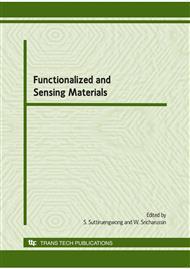p.447
p.451
p.455
p.459
p.463
p.467
p.471
p.475
p.479
Production of Polysaccharides and Corresponding Sugars from Red Seaweed
Abstract:
Recently, red seaweed attacks growing interests as 3rd generation biomass due to their notable characteristics e. g. no lignin, high CO2 fixation ability as well as high carbohydrate contents such as galactan and glucan. Seaweed may belong to one of the several groups of multicellular macro algae (the red algae, green algae, and brown algae). The ecology of seaweeds is dominated by two specific environmental requirements, that is the presence of seawater and light sufficient to drive photosynthesis. Seaweed is currently being researched as a potential source of biofuel in the form of bioehtanol. Especially, Gelidium amansii known as one of the red seaweed can be depolymerized to produce mixed monosugars such as glucose and galactose. We describe here the polysaccharide extract conditions using G. amansii to maximize the total yields of polymers and their conversion rate into monosugars which are able to be converted into bioethanol.
Info:
Periodical:
Pages:
463-466
Citation:
Online since:
January 2010
Keywords:
Price:
Сopyright:
© 2010 Trans Tech Publications Ltd. All Rights Reserved
Share:
Citation:


